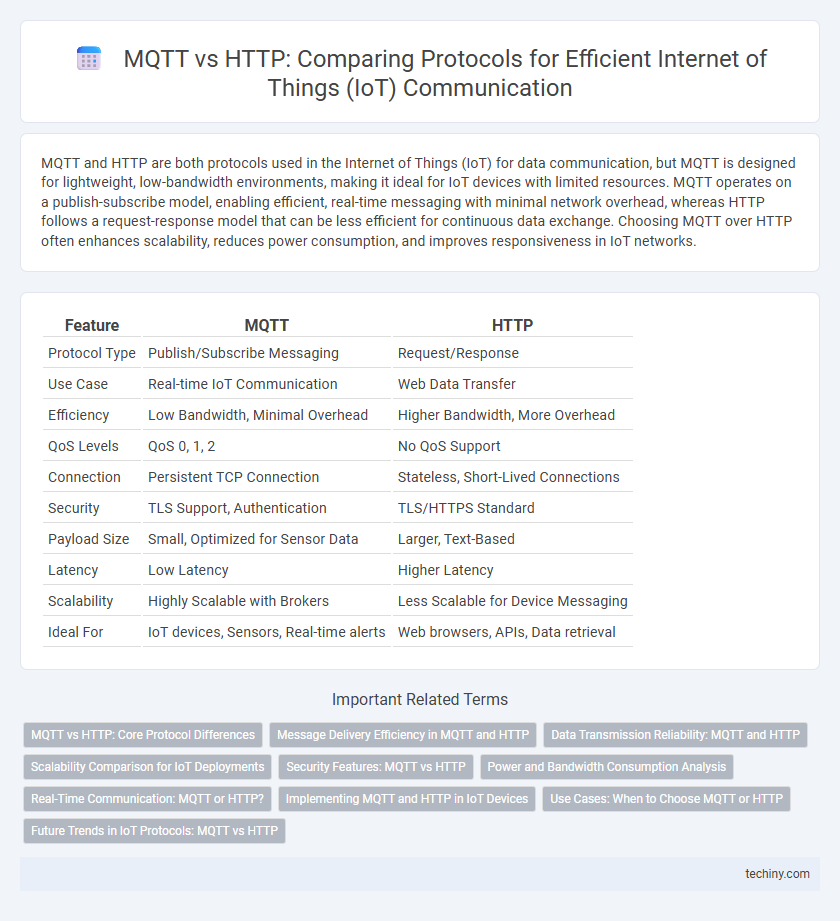MQTT and HTTP are both protocols used in the Internet of Things (IoT) for data communication, but MQTT is designed for lightweight, low-bandwidth environments, making it ideal for IoT devices with limited resources. MQTT operates on a publish-subscribe model, enabling efficient, real-time messaging with minimal network overhead, whereas HTTP follows a request-response model that can be less efficient for continuous data exchange. Choosing MQTT over HTTP often enhances scalability, reduces power consumption, and improves responsiveness in IoT networks.
Table of Comparison
| Feature | MQTT | HTTP |
|---|---|---|
| Protocol Type | Publish/Subscribe Messaging | Request/Response |
| Use Case | Real-time IoT Communication | Web Data Transfer |
| Efficiency | Low Bandwidth, Minimal Overhead | Higher Bandwidth, More Overhead |
| QoS Levels | QoS 0, 1, 2 | No QoS Support |
| Connection | Persistent TCP Connection | Stateless, Short-Lived Connections |
| Security | TLS Support, Authentication | TLS/HTTPS Standard |
| Payload Size | Small, Optimized for Sensor Data | Larger, Text-Based |
| Latency | Low Latency | Higher Latency |
| Scalability | Highly Scalable with Brokers | Less Scalable for Device Messaging |
| Ideal For | IoT devices, Sensors, Real-time alerts | Web browsers, APIs, Data retrieval |
MQTT vs HTTP: Core Protocol Differences
MQTT operates as a lightweight, publish-subscribe messaging protocol optimized for low-bandwidth, high-latency IoT environments, contrasting with HTTP's request-response model primarily designed for web communications. MQTT maintains persistent TCP connections, enabling efficient real-time data exchange with minimal overhead, whereas HTTP establishes new connections for each request, resulting in increased latency and resource consumption. The protocol's Quality of Service (QoS) levels in MQTT ensure reliable message delivery, a feature not inherently supported by HTTP, making MQTT more suitable for mission-critical IoT applications.
Message Delivery Efficiency in MQTT and HTTP
MQTT utilizes a lightweight publish-subscribe protocol designed for efficient message delivery with minimal bandwidth usage, making it ideal for IoT devices with constrained resources. HTTP relies on a request-response model that introduces higher overhead and latency due to header size and stateless connections, impacting real-time data transmission effectiveness. The persistent session and Quality of Service (QoS) levels in MQTT further enhance message delivery reliability and efficiency compared to HTTP's traditional communication method.
Data Transmission Reliability: MQTT and HTTP
MQTT offers higher data transmission reliability compared to HTTP due to its lightweight publish/subscribe protocol and three Quality of Service (QoS) levels, ensuring message delivery even in unstable network conditions. HTTP relies on a request/response model without built-in message delivery guarantees, making it less efficient for real-time IoT data exchange. MQTT's persistent session and retain flag features further enhance reliable and timely data delivery across IoT devices.
Scalability Comparison for IoT Deployments
MQTT outperforms HTTP in scalability for IoT deployments due to its lightweight protocol design and efficient use of bandwidth, enabling support for millions of devices with minimal overhead. MQTT's publish-subscribe architecture reduces network congestion and optimizes message delivery by maintaining persistent TCP connections, unlike HTTP's stateless request-response model that generates higher latency and resource consumption. Large-scale IoT platforms benefit from MQTT's ability to handle high message throughput and low power consumption, ensuring robust performance in diverse and distributed device networks.
Security Features: MQTT vs HTTP
MQTT employs lightweight TLS/SSL encryption ensuring secure data transmission for IoT devices with constrained resources, while HTTP relies on HTTPS protocols for robust security but demands higher computational power. MQTT's use of client authentication and topic-based access control enhances granular security management, compared to HTTP's traditional user-based authentication methods. The minimal overhead in MQTT reduces attack surfaces, making it more efficient and secure for real-time IoT communications than HTTP.
Power and Bandwidth Consumption Analysis
MQTT consumes significantly less power and bandwidth compared to HTTP due to its lightweight publish-subscribe messaging protocol designed for intermittent and low-bandwidth networks. HTTP's request-response model requires larger packet sizes and frequent handshakes, leading to higher energy use and network congestion. Optimizing IoT devices with MQTT enhances efficiency, prolonging battery life while reducing data transmission costs in constrained environments.
Real-Time Communication: MQTT or HTTP?
MQTT outperforms HTTP in real-time communication within the Internet of Things due to its lightweight protocol and persistent connection, enabling faster message delivery with minimal latency. MQTT's publish-subscribe model reduces network overhead and supports efficient data transmission for time-sensitive applications, unlike HTTP's request-response architecture that introduces delays. Devices using MQTT experience enhanced reliability and scalability in real-time data exchange compared to those relying on HTTP.
Implementing MQTT and HTTP in IoT Devices
Implementing MQTT in IoT devices enhances real-time communication through lightweight, publish-subscribe messaging, which reduces bandwidth usage and improves energy efficiency compared to HTTP's request-response model. MQTT's persistent session and Quality of Service levels ensure reliable data transfer, essential for device telemetry and control in constrained environments. HTTP, while more universally supported, incurs higher overhead and latency, making it less ideal for continuous, low-power IoT communications but suitable for web-based data retrieval and configuration tasks.
Use Cases: When to Choose MQTT or HTTP
MQTT excels in real-time IoT applications requiring low bandwidth and minimal power consumption, such as remote sensor monitoring and smart home automation. HTTP is more suitable for web-based or non-time-sensitive IoT use cases involving larger data payloads and standard web infrastructure, like firmware updates or device management dashboards. Selecting MQTT or HTTP depends on factors like network reliability, latency requirements, and device resource constraints in the IoT ecosystem.
Future Trends in IoT Protocols: MQTT vs HTTP
MQTT is poised to dominate future IoT protocols due to its lightweight design, minimal bandwidth consumption, and efficient publish-subscribe model ideal for constrained devices and real-time communication. HTTP, though ubiquitous and well-supported, faces challenges in scalability and latency when deployed in large-scale IoT ecosystems. Emerging trends highlight a growing preference for MQTT and MQTT-SN variants, driven by increasing demand for low-power, reliable connectivity in smart cities, industrial IoT, and edge computing applications.
MQTT vs HTTP Infographic

 techiny.com
techiny.com